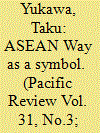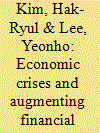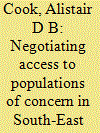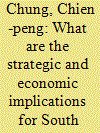|
|
|
Sort Order |
|
|
|
Items / Page
|
|
|
|
|
|
|
| Srl | Item |
| 1 |
ID:
158635


|
|
|
|
|
| Summary/Abstract |
Has the ‘ASEAN Way’ – a set of rules of the Association of Southeast Asian Nations (ASEAN) centered on the principle of non-interference and consensus decision-making – really established its position as an ASEAN norm? This paper aims to analyze the discourses of each ASEAN country and empirically explain their attitudes toward the norm. Specifically, I review various documentations to examine how various ASEAN diplomats have used the term ‘ASEAN Way.’ How did they come to call the principle of non-interference and consensus decision-making ‘ASEAN Way’ in the early 1990s? Why have they begun using the term negatively, as something to be reformed, in recent years? By describing the discourses on the ‘ASEAN Way’ and their changes over the years, I show that the rationality of non-interference and consensus decision-making has changed over time and shifted the positioning of the ‘ASEAN way’ as a symbol. This presents a new and empirical interpretation of the changes in ASEAN Norms.
|
|
|
|
|
|
|
|
|
|
|
|
|
|
|
|
| 2 |
ID:
158639


|
|
|
|
|
| Summary/Abstract |
Interpretations of the Belt and Road Initiative (BRI) mostly agree that it is a policy opening that offers some remedies for China's economic and security challenges, as well as reflects China's increasing regional and global ambitions. This paper argues that the multiple drivers characterizing the BRI result from the multiple identities of China as a developing country struggling with several sources of instability and macroeconomic problems and, simultaneously, a regional and an emerging power, and finally a major global power with significant economic capacity to shape the global economic order. The paper aims to substantiate the entanglement of the defensive and ambitious motivations behind the BRI by examining the background against which the Chinese Communist Party leadership has suggested it. In so doing, it draws on Chinese official policy documents and statistics, speeches from Chinese leaders and existing social–scientific research on the transformation of China's economic and political landscape in recent years.
|
|
|
|
|
|
|
|
|
|
|
|
|
|
|
|
| 3 |
ID:
158638


|
|
|
|
|
| Summary/Abstract |
Despite negative public opinion, the role of the Korean government has expanded, while overcoming two rounds of global financial crises. The phenomenon of the re-swelling state is mainly attributed to the strengthening of the central bureaucracy, in particular the financial bureaucracy, rather than the whole central government or the state. The argument of the strengthening of the ‘state’ or the ‘government’ after economic crises might be subject to the error of generalization. Through the two rounds of economic crises, the financial bureaucracy succeeded in acquiring the authority of market supervision and industrial support. In consequence, the bureaucracy's institutional supremacy within the government grew less challenged. The central bureaucracy was no longer the loyal servant to the President. It has reinforced its institutional strength and autonomy vis-a-vis the President, the National Assembly, the Central Bank and civil society, under the pretext of building up the rational and autonomous market and democratic politics.
|
|
|
|
|
|
|
|
|
|
|
|
|
|
|
|
| 4 |
ID:
158640


|
|
|
|
|
| Summary/Abstract |
The fall of Suharto's regime brought substantial changes in relations between Indonesia and China, and unleashed diverse perceptions of China. Reasons for these changes include the changing nature of Indonesian politics, Indonesia's position in between the US and China, and the direct results of China's policy and behaviour. In turn, sectors of Indonesian society, Indonesian business communities and the government have reacted differently and at different times to China and its growing influence. This article explores the inherent variability of Indonesia's relationship with China over the last fifteen years, which has emanated from different perceptions of Indonesian stakeholders toward China's rise.
|
|
|
|
|
|
|
|
|
|
|
|
|
|
|
|
| 5 |
ID:
158637


|
|
|
|
|
| Summary/Abstract |
South-East Asia is home to both conflict and ‘natural’ disasters which have caused significant displaced populations. Given this context, there is a need to better understand the motivations of the multiple actors involved in negotiating humanitarian responses, and to account for the impact the finished agreement has on the region both in the short and long terms. This article investigates the motivations behind two humanitarian responses in South-East Asia. The first case is the set of humanitarian responses to the Indochinese exodus in the 1970s and 1980s. The second case is the humanitarian response to those affected by Cyclone Nargis in Myanmar during the late 2000s and early 2010. Both of these agreements have been held up as historic and ground breaking achievements within the international relations of South-East Asia. This article assesses these agreements to identify the multiple levels of governance involved and the individual actors’ motivations behind them. It argues that greater appreciation of these dynamics will contribute to understanding the governance of humanitarian responses to populations of concern in South-East Asia. This will be important to consider as new crises emerge that demand new negotiations within a crowded field of actors governing humanitarian responses in the region.
|
|
|
|
|
|
|
|
|
|
|
|
|
|
|
|
| 6 |
ID:
158634


|
|
|
|
|
| Summary/Abstract |
This article examines the rise of China from the perspective of three selected countries – the Philippines, Vietnam, and Malaysia – in Southeast Asia. I argue that their perceptions of China's rise are political constructs: while the objective reality may be an increasingly powerful China, their responses have been far from uniform. They vary in ways that are shaped by their domestic politics. These constructed narratives serve their respective political agenda, from leadership legitimacy to the supremacy of a party faction. Since theories of international relations tend to fixate on power politics between great powers, this article explains how and why small regional powers add to the process of understanding China's rise. In short, regional states’ domestic politics affect their narratives of China, and therefore affect how China's rise is being understood in the region and beyond.
|
|
|
|
|
|
|
|
|
|
|
|
|
|
|
|
| 7 |
ID:
158636


|
|
|
|
|
| Summary/Abstract |
This article focuses on South Asia's role in China's Maritime Silk Road (MSR) initiative. Given the saliency of this MSR enterprise as part of ChinesePresident Xi Jinping’s “One-Belt-One-Road” strategy, how this ambitious scheme impacts China’s relations with South Asian states along the MSR’s route, i.e. India, Pakistan, Sri Lanka, Maldives and Bangladesh, merits investigation. The fate of the MSR will be determined by China’s relations with these states, since South Asia is in the middle of major sea-lanes between East/Southeast Asia and Middle East/Europe. The study examines the intentions and executions of China’s MSR projects in South Asia, evaluates the political and economic calculations of participating in the MSR for regional states, and identifies actions taken by them that can decide the initiative’s success. Politically, reactions of South Asian states to the MSR are explained as: fear of expanding Chinese influence in the Indian Ocean for India; and attempts by which Pakistan, Sri Lanka, Maldives and Bangladesh use China to counteract possible domination by India. Economically, two MSR pathways for South Asian states are analyzed: increases in Chinese infrastructure investments; and expansion in South Asia-China trade; both of which are reducible by loans owed to China, or “strings”/conditions attached.
|
|
|
|
|
|
|
|
|
|
|
|
|
|
|
|
|
|
|
|
|